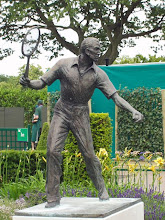
Sunday 28 October 2007
Fred Perry - A Tennis Legend
src="http://pagead2.googlesyndication.com/pagead/show_ads.js">
Frederick John Perry (May 18, 1909 – February 2, 1995) born in Stockport, Cheshire, was an English tennis player and three-time Wimbledon champion. He was the World No. 1 tennis player for 5 years, four of them consecutive, from 1934 to 1938, the first three years as an amateur. He was the last Englishman to win Wimbledon.
Born in Stockport, Cheshire, England, his father was elected to the British House of Commons as a Labour Party member. Perry was a Table Tennis World Champion in 1929 before taking up tennis at the relatively late age of 18. He had exceptional speed from his table tennis days and played with the Continental grip, attacking the ball low and on the rise. He was the first player to win all four Grand Slam singles titles, though not all in the same year. He is currently the youngest player to have achieved the Career Grand Slam, doing so at the age of 26. Perry is the last British player to win the Wimbledon men's singles title, winning it three times in a row and becoming an English icon.
In 1933 Perry helped lead his team to victory over France in the Davis Cup, which earned Great Britain the Davis Cup for the first time in 21 years
After three years as the World No. 1 tennis player while still an amateur, Perry turned professional in 1937. For the next two years he played lengthy tours against the powerful American player Ellsworth Vines. In 1937 they played 61 matches in the United States, with Vines winning 32 and Perry 29. They then sailed to England, where they played a brief tour. Perry won 6 matches out of 9, so they finished the year tied at 35 victories each. Most observers at the time considered Perry to be the World No. 1 for the fourth year in a row, sharing the title, however, with both Vines and the amateur Don Budge. The following year, 1938, the tour was even longer, and this time Vines beat Perry 49 matches to 35. Budge, winner of the amateur Grand Slam, was clearly the World No.1 player. In 1939 Budge turned professional and played a series of matches against both Vines and Perry, beating Vines 21 times to 18 and dominating Perry by 18 victories to 11.
Perry is considered by some to have been one of the greatest male tennis players to have ever played the game. In his 1979 autobiography Jack Kramer, the long-time tennis promoter and great player himself, called Perry one of the 6 greatest players of all time.
In the late 1940s Perry was approached by Tibby Wegner, an Austrian footballer who had invented an anti-perspirant device worn around the wrist. Perry made a few changes and invented the sweatband. Wegner's next idea was to produce a sports shirt which was to be made from white knitted cotton pique with short sleeves and buttons down the front. Launched at Wimbledon in 1952, the Fred Perry polo shirt was an immediate success. The brand is best known for its laurel logo, which appears on the left breast of the tennis shirts. The laurel logo (based on the old Wimbledon symbol) was stitched into the fabric of the shirt instead of merely ironed on (as was the case with the crocodile logo of the competing Lacoste brand).
The polo shirt was only available in white until the late 50s when the mods picked up on it and demanded a more varied colour palette. It was the shirt of choice for diverse groups of teenagers throughout the 1960s and 70s, ranging from the skinheads to the Northern Soul scene and Manchester's very own "Perry Boys.". The clothing brand has also become popular amongst young teens in Ireland. This sub division group has become recognisable by the Fred Perry knitwear generally purple in color with white strips. This attire can be a way of recognising the Irish working class citizens from the more "upper class".
The Fred Perry Way, named after the famous tennis champion from Stockport, is a recently designated 14 mile walking route which spans the Borough of Stockport, from Woodford in the south to Reddish in the north. The route combines rural footpaths, quiet lanes and river valleys with urban landscapes and parklands. Interesting features of the route include Houldsworth Mill and Square, the start of the River Mersey at the confluence of the River Tame and River Goyt, Stockport Town Centre, Vernon and Woodbank Parks and the Happy Valley. The route passes through Woodbank Park where Fred Perry actually played some showcase games of tennis in the park's tennis courts.
All text is available under the terms of the GNU Free Documentation License. (See Copyrights for details.)
Subscribe to:
Posts (Atom)


